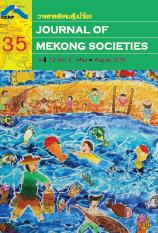Word Compounding in Tai Dam: A Reflection of People World Views and Culture
Main Article Content
Abstract
This paper shows how word compounding reflects Tai Dam world views and culture. Data were collected from ten Tai Dam informants in the lower northern part of Thailand and naturally occurring texts such as narratives and dialogues collected from Facebook. The result shows that word compounding in Tai Dam is performed in two ways: syntactic and semi-syntactic. The syntactic compounding type involves three syntactic categories such as synthetic, verb-verb, and noun-noun compounds. The synthetic strategy is the imitation of simple clauses, non-simple clauses, nominalization, and phrases. The verb-verb strategy is the combination of a main verb and its complement. And the noun-noun strategy displays various patterns of semantic relations. The semi-syntactic method is the combination that carries a number of lexical relations such as reduplicative, synonymous, similar, member, and opposite. Word compounding in Tai Dam reflects their world views and culture in terms of the folk taxonomic system of spatial entities, complex categorization, conceptualization, cultural concept & practices, and folk wisdom.


